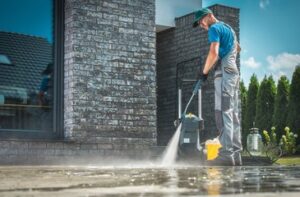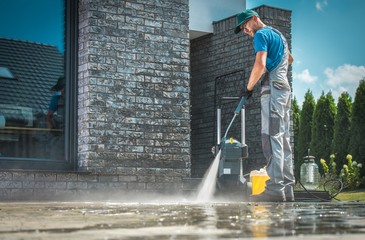Driveway paving is an important investment to enhance your property’s value and appearance. It requires special, heavy equipment at nearly every step of the process, from demolishing the old surface to laying fresh asphalt. Also called blacktop, pavement, or macadam, a driveway has two layers: a binder course and a top course. The thickness of the layer depends on your load requirements and drainage system.

SC Driveway Paving Charleston is an excellent choice for driveways because they are long-lasting and add a beautiful aesthetic to your home. However, the longevity of your paved surface will depend on how well it is maintained and installed. It is best to hire a professional with experience installing paver driveways and can advise you on the best options for your property.
Driveway paving requires substantial upfront investment and specialized knowledge of soil conditions. It is also a complex job that often involves heavy machinery, like a dump truck, jackhammer, skid steer, roller, and plate compactor. If done incorrectly, your newly paved driveway will not withstand the elements and may damage your home foundation. It is advisable to contact a local driveway paving pro to help you with this project. Still, DIYers with extensive paving experience and access to the necessary equipment can often handle the task in a few days to a week.
Before beginning the driveway paving process, your contractor must excavate and prep the site. Depending on the size of your property and the driveway, this could take several days to complete. You must have an effective drainage system so water can’t stagnate on or around the paving surface.
Next, you must lay a gravel base for the paving material. This layer should be approximately 11 inches deep. On top of this, you will need to add a layer of clean sand. This sand should be leveled and compacted with the plate compactor.
Once the sand is in place, you must lay your pavers according to your design plan. It would be best to leave about a half inch of space between each paver. If necessary, you can cut your pavers to ensure they fit properly.
Finally, you will need to install edge restraints around the perimeter of the paved area. These will help to keep the pavers in place and prevent them from shifting over time. Once you have finished, your driveway should be ready for use. You can sweep it regularly to remove dirt and debris and pressure wash it every few years to keep it fresh.
Choosing a driveway material depends on several factors, including budget and climate. Ideally, the material should complement the style of the home and fit into the surrounding landscape. In addition, it should withstand heavy traffic and weather conditions. A good contractor will survey the area and recommend a durable material for the location and climate.
For instance, a gravel driveway may be cheaper to install but difficult to shovel during snowy months. Brick or concrete pavers offer more durability and are easier to maintain. They can also be installed in various styles to match the house.
The most popular option is asphalt, which offers a low installation cost and has a lifespan of up to 30 years. However, the blacktop can crack and soften in high temperatures, which makes it prone to rutting and mud holes. It also requires resealing every few years to extend its life.
Other driveway paving materials include natural stone and interlocking pavers. Natural stone pavers are made of a wide range of rocks that are quarried, cut, and polished to create a finished product. They are generally more expensive than poured concrete and asphalt. However, they offer a distinctive, natural look and are ideal for homes with a rustic aesthetic.
In contrast, poured concrete is a common and affordable choice for most climates. Its durability and longevity make it a good investment, but can crack over time. If the surface is not properly prepared, it can become susceptible to oil and car fluid stains. It is also a more labor-intensive material to install, as it must be placed over an aggregate base.
Another driveway paving option is grass, which is environmentally friendly and easy to maintain. It’s a great alternative to traditional pavement, providing a soft surface for pedestrians and vehicles. Grass driveways also help reduce erosion and can be planted in various colors to complement the property. However, a grass driveway may require substantial watering and fertilizer, which can be costly. A more sustainable alternative is a permeable paver driveway, such as TRUEGRID, encouraging water to drain naturally into the groundwater supply.
There are many different paver colors, textures, and laying patterns. Having these options allows for an endless amount of possible combinations. When deciding on the final design for your driveway, a few key concepts need to be considered. These include the color of your home, the existing ground it is paving over, and the other structures and hardscapes surrounding it. Driveways are an important element of your property and should blend well with the rest of your outdoor space.
The most common way to tie in your driveway with the other features of your property is by incorporating the same color into the paver field or borders along the driveway. It helps to create a more cohesive look and provides a nice pop of color that makes the driveway stand out.
You can also add visual interest to your driveway by creating a unique paving pattern or introducing contrasting pavers at the border. It could be done using a different shape, size, or paver color than the rest of your project. Then, you can angle them differently from the rest of the driveway to make them stand out more.
Adding a circular paver pattern is a simple but effective way to create a focal point at the end of your driveway. It can be used to create a circle for parking, directing traffic, or simply for aesthetic appeal. To make this feature even more impressive, use a circular paver kit to form a fan or fishtail shape for an elegant Romanesque finish.
Driveways are subjected to much abuse, from vehicles and equipment to de-icing salts in the winter. That’s why it is important to work with an Authorized Contractor to establish how similar color tones, border and laying patterns, and other design elements complement one another to produce a functional and visually appealing driveway. Unilock Elegance paving stones are up to two to three times stronger than poured concrete and have the added benefit of repelling dirt, oil, and staining, so you can feel confident that your driveway will withstand the test of time.
A freshly paved driveway is an instant upgrade to your home, but maintaining its value and lifespan will take some care. Routine maintenance is the best way to avoid expensive repairs and extend the life of your pavement. A professional driveway contractor can recommend and implement preventive solutions for your paving material.
Asphalt is typically easier to repair than other materials but must still be resealed to protect against sun damage and water penetration. Sealing is typically recommended every two years. It is also important to avoid exposing the new surface to extreme temperature fluctuations.
The most critical are the first fourteen days after a repaved asphalt driveway is installed. During this time, it is important that no one drives or parks on the material. It gives the paving time to set without additional stress. Park vehicles on the street for this period.
If your asphalt shows signs of wear, resurfacing is an option. This process involves removing the top layer of the old asphalt and then installing a fresh layer on top. It can be an excellent solution to correct oxidation and other issues, and it is generally more cost-effective than replacing the entire driveway.
Weeds are a common problem for all types of driveways, but they can be particularly damaging to newly paved surfaces. They can be pulled by hand or removed using a weed eater. Often, they will send roots into your paving joints, which can cause damage over time. Regular weed removal is important to keep your paving looking its best.
While a freshly paved gravel driveway is relatively low maintenance, it must be regularly topped up to prevent the underlying soil from washing into the pavement and creating potholes. Installing a common barrier between your driveway and the yard is also recommended to avoid erosion and runoff into the grass.
The gravel is made up of loose stones, so it will not hold up well to traffic and may need to be replaced as needed. In addition, it needs to be resealed annually to protect against moisture.

